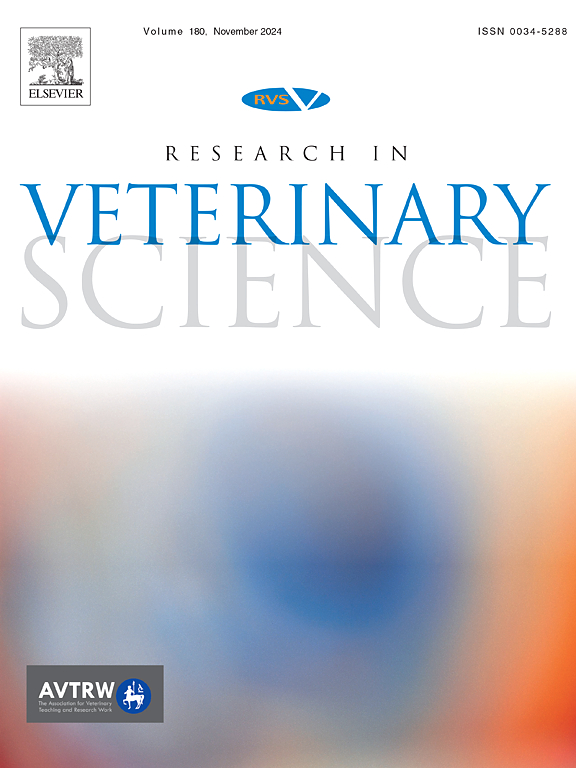温度和pH值影响人类和奶牛沙门氏菌病的动力学模型。
IF 2.2
3区 农林科学
Q1 VETERINARY SCIENCES
引用次数: 0
摘要
全世界每年约有2000万例沙门氏菌病病例和15万人死亡。提出了一种基于常微分方程的机械区室模型来评估温度和pH值对沙门氏菌病传播动力学的影响。研究了该疾病在温度和pH胁迫地区的传播潜力。采用新一代矩阵法计算温度- ph依赖性繁殖数。利用李雅普诺夫稳定性理论和后向分岔分析对系统的动力学状态进行了研究。采用拉丁超立方抽样(LHS)和偏秩相关系数(PRCC)方法对不确定性和全局敏感性分析进行了检验。采用95%置信区间(CI)对模型参数进行了可靠性评估,并对模型在有利温度和不利温度条件下进行了数值模拟。分析表明,肠道沙门氏菌亚群的摄食率。人与奶牛中伤寒鼠伤寒杆菌的人传人率、牛与牛传人率、人的脱落率、奶牛的脱落率以及生产污染乳制品的比率与感染的人和感染的奶牛的数量成正比。温度范围为100 ~ 200℃和300 ~ 400℃,ph值大于3.8对沙门氏菌病的动态有显著影响。为了消除沙门氏菌病,研究建议在夏季和温度范围为100 -200摄氏度的地区使用推荐的化学消毒剂处理天然水体,在最热的温度下烹饪食物,并在所有ph值的最低温度下储存食物。本文章由计算机程序翻译,如有差异,请以英文原文为准。
Dynamical modeling of Salmonellosis in humans and dairy cattle with temperature and pH effects
Approximately 20 million cases and 0.15 million human fatalities worldwide each year are caused by Salmonellosis. A mechanistic compartmental model based on ordinary differential equations is proposed to evaluate the effects of temperature and pH on the transmission dynamics of Salmonellosis. The transmission potential of the disease in areas with temperature and pH stresses is examined. The next-generation matrix method is applied to compute the temperature-pH-dependent reproduction number . The dynamical regimes of the system are examined using Lyapunov stability theory and backward bifurcation analysis. The uncertainty and global sensitivity analysis are examined using the Latin Hypercube Sampling (LHS) and Partial Rank Correlation Coefficient (PRCC) methods. The numerical simulations of the proposed model under favorable and unfavorable temperatures are performed with a confidence interval (CI) for the reliability assessment of the model parameters. The analysis shows that the ingestion rates of Salmonella enterica subsp. enterica serovar Typhimurium bacteria in humans and dairy cattle, human-to-human transmission rate, cattle-to-cattle transmission rate, human shedding rate, dairy cattle shedding rate, and the rate of producing contaminated dairy products are directly proportional to the number of infected humans and infected dairy cattle. The temperature ranges of and and pHs greater than 3.8 have a significant effect on the dynamics of Salmonellosis. In order to eliminate Salmonellosis, the study recommends treating natural water bodies using the recommended chemical disinfectants during summer seasons and in areas with temperature ranges of , cooking food at the hottest temperatures, and storing food at the lowest temperatures for all pHs.
求助全文
通过发布文献求助,成功后即可免费获取论文全文。
去求助
来源期刊

Research in veterinary science
农林科学-兽医学
CiteScore
4.40
自引率
4.20%
发文量
312
审稿时长
75 days
期刊介绍:
Research in Veterinary Science is an International multi-disciplinary journal publishing original articles, reviews and short communications of a high scientific and ethical standard in all aspects of veterinary and biomedical research.
The primary aim of the journal is to inform veterinary and biomedical scientists of significant advances in veterinary and related research through prompt publication and dissemination. Secondly, the journal aims to provide a general multi-disciplinary forum for discussion and debate of news and issues concerning veterinary science. Thirdly, to promote the dissemination of knowledge to a broader range of professions, globally.
High quality papers on all species of animals are considered, particularly those considered to be of high scientific importance and originality, and with interdisciplinary interest. The journal encourages papers providing results that have clear implications for understanding disease pathogenesis and for the development of control measures or treatments, as well as those dealing with a comparative biomedical approach, which represents a substantial improvement to animal and human health.
Studies without a robust scientific hypothesis or that are preliminary, or of weak originality, as well as negative results, are not appropriate for the journal. Furthermore, observational approaches, case studies or field reports lacking an advancement in general knowledge do not fall within the scope of the journal.
 求助内容:
求助内容: 应助结果提醒方式:
应助结果提醒方式:


